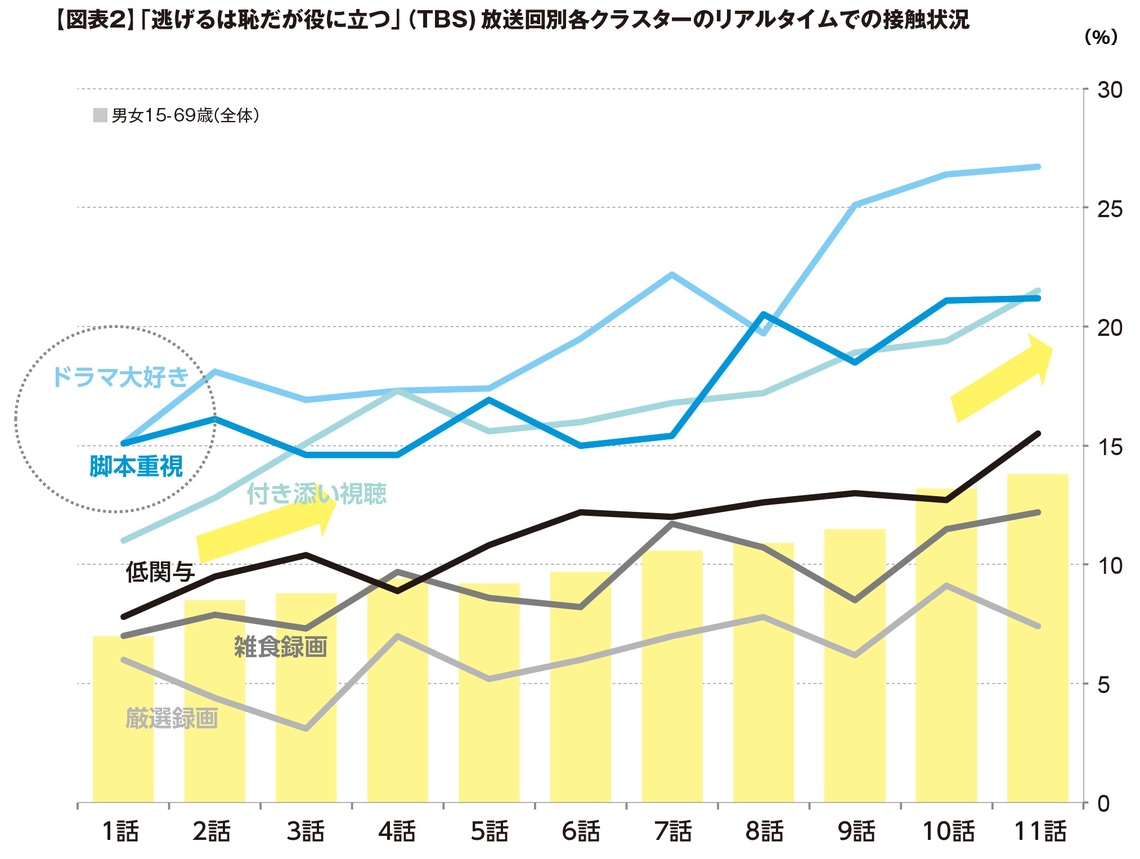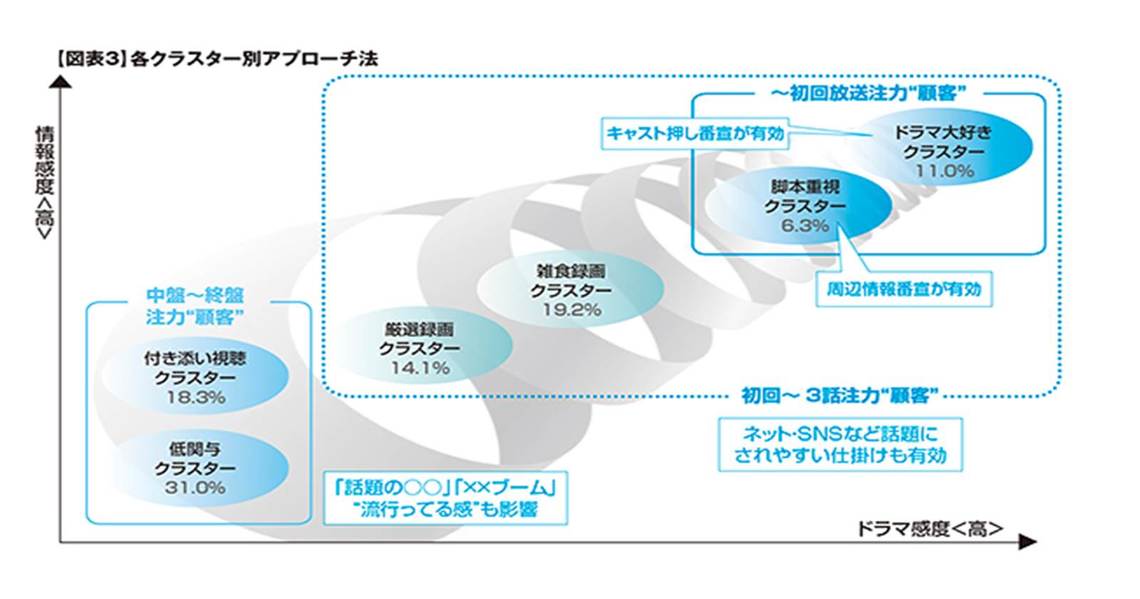Note: This website was automatically translated, so some terms or nuances may not be completely accurate.
How do you watch dramas?
Video Research Ltd. conducts a survey called "VR CUBIC" that mechanically measures "TV × Internet" usage patterns to support companies' total communication activities, encompassing both offline and online efforts(※1).
We analyzed data from this "VR CUBIC" survey and developed "Drama Clusters" that categorize TV drama viewers based on their viewing preferences.
Six Drama Clusters
It's easy to imagine that even among drama lovers, the reasons for watching and the elements they seek vary greatly. Therefore, we excluded people who never watch dramas and analyzed actual drama viewers, finding they could be classified into six distinct types. Let's take a look at each one.
① Drama Enthusiast Cluster (11.0%)
Note: Figures in parentheses indicate the volume of this cluster among drama viewers

As the name suggests, this group consists of women, primarily F3 and F2 (※2), who are passionate about dramas. They actively seek out drama-related information, checking each network's new drama lineup every season.
They also strongly prefer real-time viewing, exert significant influence on ratings, and possess strong word-of-mouth influence regarding dramas. They play a role in encouraging others to watch, making capturing this group crucial for a drama's success. Promotional spots and in-program announcements are highly effective with this group, making their use essential.
② Script-Focused Cluster (6.3%)

This group prioritizes source material, screenplays, and direction. It's also composed primarily of women in the F3 and F2 demographics. They are very active in gathering drama information and are the second most influential group after the "Drama Lovers Cluster" in terms of ratings impact.
Similar to the "Drama Enthusiast Cluster," promotional spots and in-program announcements are effective. However, they also frequently use EPGs (Electronic Program Guides), making the skillful use of these communication tools essential.
③ Omnivorous Recording Cluster (19.2%)
 This group has an eclectic viewing style: they record dramas first and foremost, then decide whether to watch based primarily on the cast rather than the genre.
This group has an eclectic viewing style: they record dramas first and foremost, then decide whether to watch based primarily on the cast rather than the genre.
The gender ratio is roughly equal, with F2 and M2 forming the core of this group.
They don't have strong attachments to specific shows, tending to keep watching out of habit. Their level of drama-related information gathering isn't as high as the previous two groups. Since they primarily watch recorded episodes, this group has a low influence on live viewership ratings.
④ Selective Recording Cluster (14.1%)

This group records and watches only programs that match their preferences. It has a slightly higher male ratio, with M3 and M2 as the core demographic. While they gather basic information about dramas, they strictly select programs based on their personal tastes, showing a preference for established genres like crime, suspense, and mystery.
Similar to the "Omnivorous Recording Cluster," this group primarily watches recorded content, so their influence on ratings is low.
⑤ Accompanying Viewing Cluster (18.3%)

This is a co-viewing group that watches dramas alongside a family member who is watching. It is centered around M3. They have little particular attachment to dramas, though if pressed, they tend to like crime dramas, suspense, and mysteries. However, they strongly prefer real-time viewing, making them a group that ultimately exerts influence on ratings.
⑥ Low-Engagement Cluster (31.0%)

This group shows low interest in dramas overall, typically watching one per season at best. Centered around M3 and M2, it has a high male ratio. They strongly follow trending content and react sensitively to "popularity" and "buzz,"
If they sense something is "trending" online, they may start watching.
Plotting these six clusters on axes of drama sensitivity (≈ drama enthusiasm) and
and information sensitivity (≈ drama information gathering ability), the result is a plot like the one shown in [Figure 1].

"We Married as a Job!" captured all clusters as episodes progressed
Now, let's examine how viewers in each cluster actually watched the drama using the case of last year's smash hit "We Married as a Job" (TBS).
The bar graph in [Figure 2] shows the real-time contact rate (※3) trend for each broadcast episode. Similar to actual TV ratings, it clearly shows an upward trend with each episode.
The contact rates for each cluster are shown in the line graph. First, we see that the "Drama Enthusiast Group" – including those who "Love Dramas" and "Prioritize Scripts" – reacted strongly to the premiere.
This may have been influenced by the lead role being played by Yui Aragaki, who has frequently appeared in popular works in the past, and the fact that it was based on a comic.
Subsequently, aided by online and SNS buzz around elements like the "Love Dance" and "Muzukyun," episodes 2 and beyond saw reactions from "Followers" groups such as "Accompanying Viewers" and "Low-Engagement Viewers." Notably, these two "Follower" groups significantly contributed to the surge in contact rate for the final episode.
Meanwhile, while the "Omnivorous Viewers" and "Selective Viewers" groups maintained lower real-time contact rates compared to other groups, they showed a steady upward trend. This suggests a gradual emergence of the desire to "watch as soon as possible," leading them to start watching in real time.

Recording groups become the spark for buzz
By inferring the pattern of information diffusion between clusters based on the timing of contact rate reactions for each cluster, we observe that the "Drama Enthusiast Group" – the driving force for initial viewership, characterized by "Drama Lovers" and "Script-Focused" – acted as the spark, spreading to "Followers" such as the "Accompanying" and "Low-Engagement" groups.
Furthermore, while "Recording Groups" (e.g., "Omnivorous Recorders," "Selective Recorders") are less directly linked to real-time viewing, they prove crucial targets for gaining a drama's buzz.
Particularly for "We Married as a Job!", online buzz around elements like the "Love Dance" and "Muzukyun" likely influenced the "Followers Group". It is inferred that the viewing experiences and discussions generated by the "Drama Enthusiasts Group" and "Recording Group" were the catalysts for the boom.
For broadcasters, dramas—except for some series—are essentially "short-term battles," with new content launched every three months. Due to this nature, the initial viewership ratings from the first to third episodes often establish a baseline. Consequently, maximizing awareness and viewership through promotional spots and in-program announcements before the premiere becomes a key communication challenge for each network.
We believe this drama cluster offers a new angle to further boost drama excitement. Therefore, we will now organize how broadcasters should approach these six viewer types, categorized by timing.
How to Approach Each Cluster?
<Timing 1: Pre-Broadcast> Until the First Episode
The key viewers to focus on before the premiere are the "Drama Lovers" and "Script Focus" clusters, as they directly influence the premiere ratings. The stronger the connection with these two groups, the higher the premiere ratings are likely to be.
The "Drama Lovers" cluster is strongly cast-oriented, while the "Script Focus" cluster tends to be more receptive to peripheral information like source material, screenplay, and direction. Both groups are highly receptive to promotional spots and in-program announcements. It's advisable to identify distinct appeal points for each cluster and develop tailored promotional and announcement strategies.
<Timing 2: Mid-Season> First Episode to Episode 3
The key customers to focus on from the start of broadcast through Episode 3 are the top four clusters that hold the key to the drama's overall "evaluation": "Drama Lovers," "Script Focus," "Omnivorous Record," and "Selective Record."
While there is a difference in reaction timing between the real-time viewers ("Drama Lovers" and "Script Focused") and the recorded viewers ("Omnivorous Recorders" and "Selective Recorders"), both groups possess strong information-gathering capabilities regarding the drama. They respond to the "mechanisms" set up by the broadcaster and actively spread the word. Particularly, the "Selective Recorders" are a target group you'll want to effectively utilize when marketing dramas like crime, suspense, or mystery genres.
<Timing 3: Late Stage> Mid-to-late episodes
The key "customers" are the two clusters that influence the drama's overall ratings: "Accompanying Viewers" and "Low-Engagement Viewers." These two segments make up a substantial 49.3% of the drama audience, forming the core volume zone. The battle is won or lost based on capturing this segment from the mid-point onward.
While these two segments do not proactively seek out drama information, they respond to co-viewing with "drama enthusiast groups" and topics spread by the "recording group" on social media. They are targets easily influenced by framing like "The Hot Topic Right Now" or "The ×× Boom." Given their strong real-time orientation, they should be defined as the target audience when selecting "mid-season boost" programs for the drama's mid-to-late stages.
The above discussion is summarized in [Figure 3].

This time, we introduced the details of the "Drama Cluster" as a case study for broadcasters. Based on such analysis results in the communication domain, our company offers numerous solutions that translate into actionable strategies. We aim to assist not only broadcasters but also anyone facing digital challenges, such as CRM activities, DMP construction, and developing high-precision advertising delivery segments.
Thank you very much for reading!
※1: VR CUBIC is a single-source panel that mechanically measures "TV × Internet" usage patterns to support all aspects of a company's offline and online communication activities.
Using collected logs, it not only measures the overall "quantity" of reach for advertising campaigns, accounting for overlapping exposure to "TV × Internet," but also enables surveys of monitors. This allows for measuring the "quality" aspect of advertising effectiveness, such as what attitude changes were achieved based on the degree of ad exposure.
This paper analyzes data from 2,412 VR CUBIC monitors (N=3,007) who responded to a January 2017 survey on drama viewing habits, excluding those who answered "I never watch dramas."
※2: A targeting classification used in media, including Video Research Ltd.'s viewership ratings surveys. M represents Male, F represents Female, and age groups are categorized as: 1st tier: 20-34 years old, 2nd tier: 35-49 years old, 3rd tier: 50 years old and above.
Gender (M/F) and age (1st-3rd tier) are combined to express gender and age.
M1: Men aged 20–34, M2: Men aged 35–49, M3: Men aged 50 and over
F1: Women aged 20–34, F2: Women aged 35–49, F3: Women aged 50 and over
※3: This designation is used because the data differs from the television ratings survey data conducted by our company.
Was this article helpful?
Newsletter registration is here
We select and publish important news every day
For inquiries about this article
Author

Masayuki Kawabe
Video Research Ltd.
Sales Division, Digital Business Promotion Department
Joined the company in 2002. Primarily engaged in survey design and analysis related to program evaluation and promotional ad placements as a sales representative for broadcasting stations. Since 2016, involved in visualizing communication activities across television and the internet using VR CUBIC, and disseminating insights. Currently supports clients in solving challenges within the digital domain at the Digital Business Promotion Department, Sales Division.
